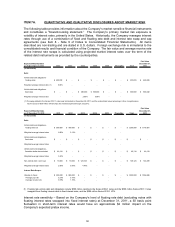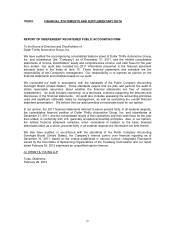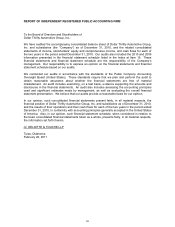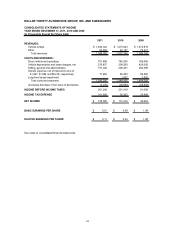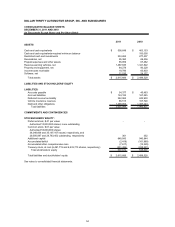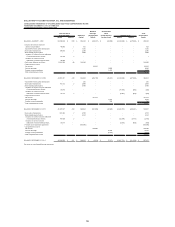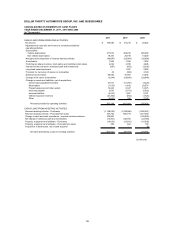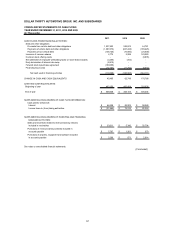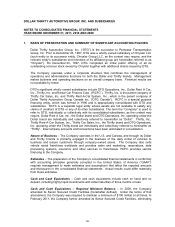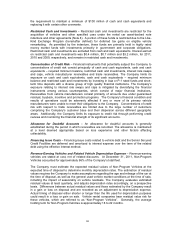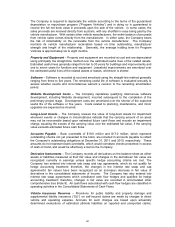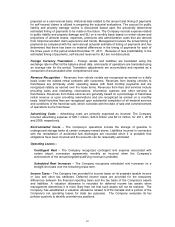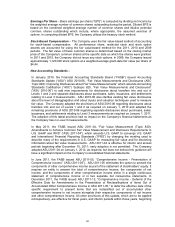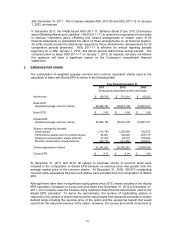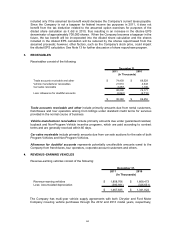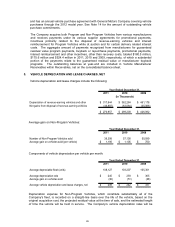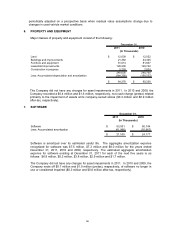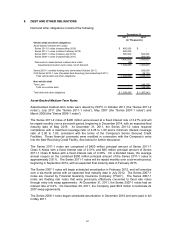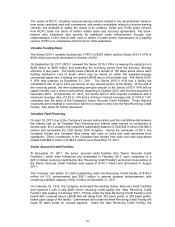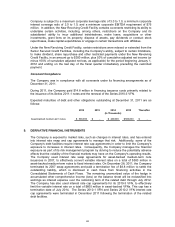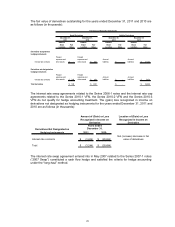Thrifty Car Rental 2011 Annual Report Download - page 62
Download and view the complete annual report
Please find page 62 of the 2011 Thrifty Car Rental annual report below. You can navigate through the pages in the report by either clicking on the pages listed below, or by using the keyword search tool below to find specific information within the annual report.The Company is required to depreciate the vehicle according to the terms of the guaranteed
depreciation or repurchase program (“Program Vehicles”) and in doing so is guaranteed to
receive the full net book value in proceeds upon the sale of the vehicle. In some cases, the
sales proceeds are received directly from auctions, with any shortfall in value being paid by the
vehicle manufacturer. With certain other vehicle manufacturers, the entire balance of proceeds
from vehicle sales comes directly from the manufacturer. In either case, the Company bears
the risk of collectability on the receivable from the vehicle manufacturer. The Company
monitors its vehicle manufacturer receivables based on time outstanding, manufacturer
strength and length of the relationship. Generally, the average holding term for Program
Vehicles is approximately six to eight months.
Property and Equipment – Property and equipment are recorded at cost and are depreciated
using principally the straight-line method over the estimated useful lives of the related assets.
Estimated useful lives generally range from ten to 30 years for buildings and improvements and
one to seven years for furniture and equipment. Leasehold improvements are amortized over
the estimated useful lives of the related assets or leases, whichever is shorter.
Software – Software is recorded at cost and amortized using the straight-line method generally
ranging from three to five years. The remaining useful life of software is evaluated annually to
assess whether events and circumstances warrant a revision to the remaining amortization
period.
Website Development Costs – The Company capitalizes qualifying internal-use software
development, including Website development, incurred subsequent to the completion of the
preliminary project stage. Development costs are amortized over the shorter of the expected
useful life of the software or five years. Costs related to planning, maintenance, and minor
upgrades are expensed as incurred.
Long–Lived Assets – The Company reviews the value of long-lived assets for impairment
whenever events or changes in circumstances indicate that the carrying amount of an asset
may not be recoverable based upon estimated future cash flows and records an impairment
charge, equaling the excess of the carrying value over the estimated fair value, if the carrying
value exceeds estimated future cash flows.
Accounts Payable – Book overdrafts of $19.0 million and $17.0 million, which represent
outstanding checks not yet presented to the bank, are included in accounts payable to reflect
the Company’s outstanding obligations at December 31, 2011 and 2010, respectively. These
amounts do not represent bank overdrafts, which would constitute checks presented in excess
of cash on hand, and would be effectively a loan to the Company.
Derivative Instruments – The Company records all derivatives on the balance sheet as either
assets or liabilities measured at their fair value and changes in the derivatives’ fair value are
recognized currently in earnings unless specific hedge accounting criteria are met. The
Company has entered into interest rate swap and cap agreements, which do not qualify for
hedge accounting treatment; therefore, the changes in the interest rate swap and cap
agreements’ fair values have been recognized as an (increase) decrease in fair value of
derivatives in the consolidated statements of income. The Company has also entered into
interest rate swap agreements which constituted cash flow hedges and qualified for hedge
accounting treatment; therefore, changes in fair value are recorded in accumulated other
comprehensive loss (Note 9). All cash flows associated with cash flow hedges are classified in
operating activities in the Consolidated Statements of Cash Flows.
Vehicle Insurance Reserves – Provisions for public liability and property damage and
supplemental liability insurance (“SLI”) on self-insured claims are made by charges to direct
vehicle and operating expense. Accruals for such charges are based upon actuarially
determined evaluations of estimated ultimate liabilities on reported and unreported claims,
60


